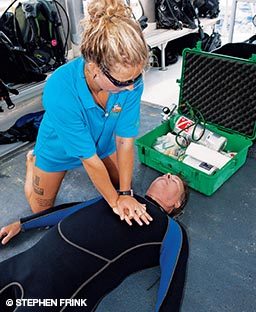Emergency Action Plans
History teaches us that accidents are always possible, thus we should have plans in place to mitigate them. Clients as well as staff, bystanders, dive professionals and the dive business itself are subject to risk.
Emergency action plans (EAPs) are essential tools for dive professionals and dive businesses. These plans typically provide information needed in case a dive accident occurs, although this consideration is usually limited to traditional diving activities or expected problems. Comprehensive EAPs must address a variety of risk areas, and few people understand what goes into identifying, compiling, reviewing and qualifying a truly effective EAP.
This article is the first in a series that will cover the essentials of planning an effective and practical emergency procedure to help mitigate dive-industry-related incidents. First we’ll consider where emergencies are likely to occur.
The risks vary by dive center, dive professional and area of operation, so we need a careful analysis to identify the real issues. Here is at least a partial list of possible risks to help identify areas of concern.
- At the dive center: fires; explosions of high-pressure cylinders, gas tanks or containers of hazardous fluids; contact with chemicals or other hazardous materials; injuries from electrocution; social unrest or other involvement with aggressive people
- At the pool and training areas: exposure to hazardous substances (such as chlorine); medical emergencies (including from preexisting health problems); injuries (from slipping, diving, falling or lifting heavy objects); drowning
- While diving: traumatic injuries from propellers, ladders, slipping, diving or heavy objects, for example; encounters with hazardous marine life; lost divers; drowning; medical emergencies due to health conditions; entry and exit hazards associated with rocky shores or difficult-to-access caves or pools
- During transportation (on land or on the water): fire; inclement weather; capsizing; loss or incapacitation of people; launch accidents; road accidents; hijacking of a vessel or vehicle

Beyond the most readily identifiable risks are others that, though unlikely, warrant consideration and preparedness. These may be present in any of the areas listed previously or elsewhere:
- a lost, abducted or wounded guest
- unacceptable or aggressive behavior by a guest, staff member or visitor
- sudden ill health or a medical emergency
- criminal activity or arrest, death or homicide involving a guest or staff member
An important location-specific aspect of emergency planning that should be addressed for all areas considered in an EAP is the availability and reliability of local emergency medical and law-enforcement services.
By illustrating these hazards and their potential locations, we hope to inspire dive businesses and self-employed dive professionals to think through their EAPs in greater depth.
There will always be risks, but with better knowledge, understanding and preparedness we can reduce uncertainty and better contain the consequences of the hazards we will eventually face.
© Alert Diver — Q4 2017